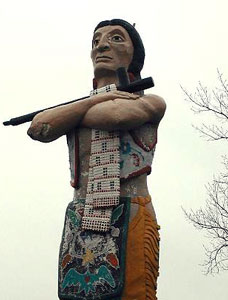The Hiawatha statue has been a prominent feature in La Crosse's Riverside Park for 40 years. It's four stories tall and wears a colorful vest, buckskins and a loin cloth. His arms are folded and cradle a peace pipe. The name Hiawatha comes from the popular Longfellow poem, but most locals refer to it as The Big Indian. The statue is in dire need of repair. But when city officials discussed spending up to $50,000 to resurface and paint it, they heard from people like Matt Stewart. He's the co-chair of the Native American Student Association at the University of Wisconsin-La Crosse.
"It is a gross amalgamation of native people and native cultures. It's a fictionalization of native people and those cultures. It's a stereotype that needs to be gone," Stewart says.
Stewart, a sophomore at the university, also works for the Wisconsin Indian Education Association to rid the state of offensive high school team mascots. He says it's difficult to convey to non-Native Americans just how damaging such images are.
"These are on our food and on alcohol and on clothing. The problem is so widespread because it is so ingrained in the American psyche," he says. "It's part of the American myth; this idea of the frontier, of the noble savage. This idea is part of the axiology of being an American."
Stewart says the statue's hook nose, the clothing, the peace pipe, and the folded arms add up to a cartoon image of how one non-native person views Indian culture.
Still, lifelong La Crosse resident Virginia Zweifel is among those who don't see what the fuss is all about. She's already seen her former high school change its Red Raiders mascot, and the university's football team switch from the Indians to the Eagles 10 years ago. She says Hiawatha is a tribute, not a slight.
"I can't see in any way that they find this statue offensive. I don't understand it at all. There's nothing offensive about the statue. It's a part of history. People nowadays are so paranoid about being discriminatory that I think they overreact the opposite way," Zweifel says.
The figure isn't a savage warrior wielding a tomahawk and it isn't a noble chief in a headdress. He's wearing a vest, so he's not half-naked, and he doesn't have feathers. True, he has a slightly big nose and he's standing stoically with his arms crossed, but these are far from the worst offenses we've seen.
As usual, I'd base my reply on how accurate the statue is. If it accurately represented a La Crosse-area Indian, I wouldn't waste time on the small flaws. If it was only semi-accurate, I'd say keep it but add a plaque noting the problems from a Native viewpoint. If it was wholly inaccurate, I'd say move it to a less prominent location or put it in storage.
There probably should be an explanatory plaque in any case. It could say how this is an outdated image of Indians that's no longer relevant. That today Wisconsin has 11 tribes that are involved in modern life but still practice their traditional cultures.
For more on the subject, see Big Indians as Roadside Art and Best Indian Monuments to Topple.


1 comment:
You beat me to this one. I have at least one postcard of him and plan to use it in a future post. I will still be doing this in the future. I have been to La Crosse and Riverside Park, but somehow have managed to miss seeing the statue.
"If it accurately represented a La Crosse-area Indian..."
The La Crosse area Indians have been Ho-Chunk (Winnebago) for quite some time. Ho-Chunk is not among the tribes associates with the real and legendary Hiawatha, so I think they could get a pass on it not being an authentic Ho-Chunk representation and clearly being labelled "Hiawatha".
La Crosse is in the Hiawatha Valley, but lacks connection to "The Song of Hiawatha".
Ideally, there'd be a very accurate depiction of an actual La Crosse Ho-Chunk leader such as Decorah One-Eye in the park or in La Crosse.
Post a Comment